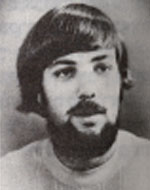Nechushtan (Warshavsky), Boaz
Boaz, son of Tzipora and Israel, a Holocaust survivor, was born on March 31, 1950, in Tel Aviv. He studied at the Neve Magen Elementary School in Ramat Hasharon and then went on to study there in high school. He graduated from Kibbutz Ramot Menashe in the framework of joint education. Boaz was a lively and energetic student. He was one of the founders of the local Hashomer Hatzair branch and concentrated his activities around him. Within the framework of the youth movement, Boaz found a full outlet for the vigor and passion that was in him. He organized various parties and events, planned activities and embarked on many trips. The ideas he absorbed in the movement, and the way he lived in those years, influenced him greatly. His friends from that period remember him as an open boy and full of thirst to know the new life he chose to live. Since it was easy for him to connect with people, he quickly became acquainted with many members of the economy. His approach to life was full of optimism. Even in the moments when despair was perceived of society, of itself and of life in general, he knew that this was a fleeting moment, after which he could once again find satisfaction and interest in life. Boaz believed in the people and the goodness that’s hidden among them. He hurt the pain of friends whose life’s hardships made them a sort of “machine” that no longer felt pain or joy. He understood very well that such changes often occurred in a person without feeling them, so he would check himself and his truths every day anew. Only if they were reconfirmed did he cling to them and continue to live according to it. In one of his letters he scorned with pity the people who always follow others and dare not initiate their own action. Throughout his life, Boaz did not except only with what was presented to him. He always had ideas on how to improve, innovate, and build new things. In one of his letters, he wrote: “Basically, one must be optimistic and hope for the best and the highest … We must always see the problems in the right proportions, so that the positive and the pink will stand out, and we can conclusively conclude that the situation is not bad. With such views on life and people, it is no wonder Boaz felt comfortable within the kibbutz society. His quiet character, his willingness to give without standing out, and his simplicity of conduct found great strength in the calm atmosphere of the kibbutz education, where there is no need to compete and push forward at the expense of friends. Boaz was drafted into the IDF at the end of July 1968 and was assigned to the Nahal Brigade together with his comrades in the group. After basic training, he underwent a combat paramedics course and then did various assignments. Although he did not like army life and could not understand those who were enthusiastic about preparations for a possible war, he fulfilled the duties assigned to him in a complete and efficient manner. When he was converted to the Armored Corps by virtue of his security needs, he underwent a course in the Armored Corps and became an excellent tank driver. At the time he wrote: “I am not the most humane person in the world, but to think that I will become a war machine or at least an important screw in such a machine is inconceivable.” Boaz was happy when his release date came, and in March 1973 he settled in Kibbutz Dalia and married his girlfriend Yael. The future now seemed full of promises for a long and happy life, but it did not. During the Yom Kippur War, Boaz took part in the braking battles in the area of the Nahaf camp in the Golan Heights, as a tank driver. On October 7, 1973, his tank was hit and he was killed. He was brought to eternal rest in the cemetery at Kibbutz Dalia. He left behind a wife and daughter, parents, sister and brother. After his fall, he was promoted to First Sergeant. In a letter of condolence to the bereaved family, his commander wrote: “He fulfilled his duty with devotion and loyalty, his professional ability and his devotion to the cause during the fighting served as an example to his comrades.”
